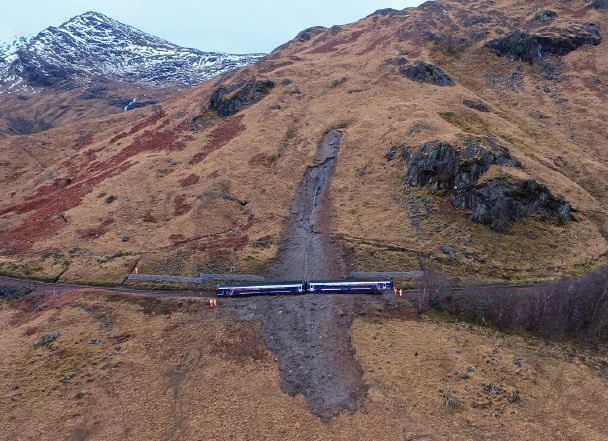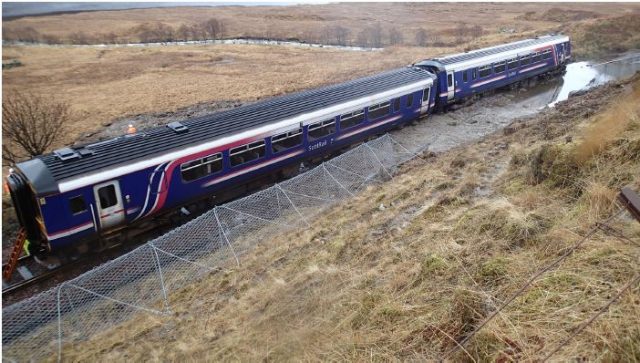2 September 2019
The landslide-induced train derailment at Lock Eilt in Scotland in January 2018
Posted by Dave Petley
The landslide-induced train derailment at Lock Eilt in Scotland in January 2018
On 22nd January 2018 a train was derailed by a landslide at Loch Eilt in north-west Scotland, fortunately with no loss of life. The image below shows the aftermath of the event:-

The aftermath of the train derailment at Loch Eilt in Scotland on 22nd January 2018. Image from the RAIB report into the incident.
.
A few months later the Rail Accident Investigation Branch published a report, available online, into the accident. The report is well-written, providing a very clear narrative about the events on the day. It found that the landslide occurred as a result of rapid thaw after a period of cold weather, which in turn followed a phase of wet weather. Thus, the ground was saturated and frozen, with some snow cover. The increase in temperatures released substantial amounts of water, triggering the landslide.
Of particular interest is the presence of the catch fence, which was overrun by the landslide debris, as shown in the image below, also from the RAIB report:-

The damaged catch fence at Loch Eilt in Scotland on 22nd January 2018. Image from the RAIB report into the incident.
.
The UK has a byzantine structure for running the railways, with the track being managed by a not for profit, government-owned entity called Network Rail, which is separate from the train operators. In 2015, Network Rail commissioned a consultant to examine the slopes in the Lock Eilt area, with an initial focus on rockfalls and boulder incursions, but with a subsequently expanded remit to include minor landslides originating from beyond the railway boundary. This study concluded that there was a risk of boulder incursion at this point; the catch fence was constructed to capture such events. The RAIB report indicated that in tests the fence design had successfully retained a 3 tonne boulder travelling 30 m down a 35° slope.
The landslide itself had a volume of between 500 and 600 m³, and thus has a mass of over 1000 tonnes. The landslide scar extended 80 m beyond the railway boundary, with a height difference of 46 metres. As such, the fence could not be expected to retain this landslide.
The event illustrates the difficulties of assessing the type of failure that might occur at a given location, even when the slopes are known to be potentially unstable. Mitigation works depend on this assessment to be effective, but the range of failure types is so complex that undertaking these assessments is a major challenge. Network Rail, and its consultants, have to manage over 16,000 km of railway track in the UK, much of which sits adjacent to slopes. The magnitude of the task is clear, especially as the slopes become more vulnerable to failure as a result of climate change.


 Dave Petley is the Vice-Chancellor of the University of Hull in the United Kingdom. His blog provides commentary and analysis of landslide events occurring worldwide, including the landslides themselves, latest research, and conferences and meetings.
Dave Petley is the Vice-Chancellor of the University of Hull in the United Kingdom. His blog provides commentary and analysis of landslide events occurring worldwide, including the landslides themselves, latest research, and conferences and meetings.